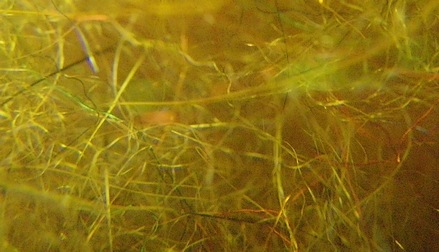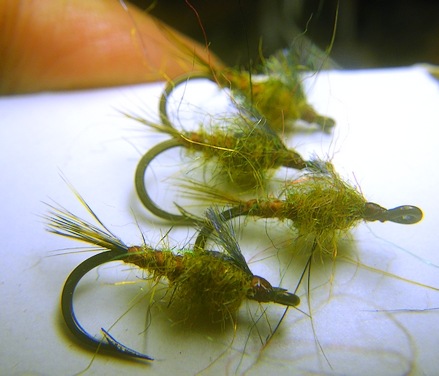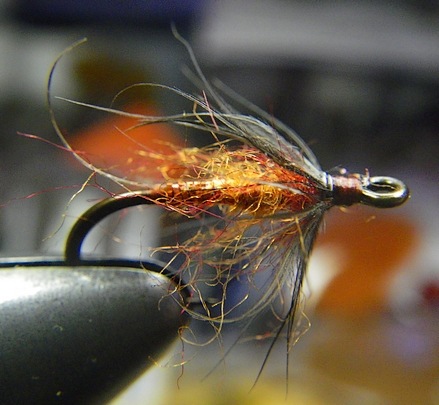The concept is sound, I donate 99% to the care and feeding of your lifestyle, you return 1% to something that allows underprivileged kids to kill even more fish…
Is that what you meant by angling charity?
My Inbox is a steady stream of anglers whose high dollar sunglasses perch fetchingly on carefully rolled curly-brim, who insists that membership in their company dictates I should be more green, more ecologically sensitive, more caring, and more demonstrative …
… with my paycheck, naturally.
In typical fashion, some well meaning Montana angler is concerned about the environment and invents strike indicators of corn yarn, which degrades nicely in water, is green as hell and absolves the brotherhood of explaining why bobbers are necessary to catch trout given that their bright colors bob in the bankside grasses and line most of the landscape.
Knopp creates the indicators by cutting the yarn into lengths and tying a loop into the middle. Then he coats the entire product in an organic paste to help it float. The final touch is coating the loop in beeswax. He plans to package them three to a bag and sell them for $10.
That “lifestyle” tag is going to blind me to the fact that 100 yards of the corn yarn is $8, or that plastic bubble-style floats are five to the pack and a third the price of corn?
… and we daren’t mention we took bread out of the mouths of babes – corn being a foodstuff and better used as aid to some drought stricken province teetering on the brink, versus floating some fly down an expensive resort river, with that doubly expensive guide hovering over your every move.
So why is it that the “Green” idea always has to cost more at the register, can’t we feel strongly about the environment and undercut the bobbercator price versus always doubling it?
Jesus only requires 10% of your get, can Mother Nature be that much more in tune with inflation?
I’d love to limit my studies to insect lifecycles and ignore the faded Miami Vice pastel tee shirts at $25 per, each labeled with a fetching Catch & Release logo that I’ll have to explain to my girlfriend, who’ll think me a poor risk to be her baby-daddy and dump me before I can release her…
I recognize that Sesame Street filled your heads with the expectations that you’ll get some cookie too, but it appears that boat’s sailed and isn’t likely to avoid any iceberg.
As you skipped over history and aren’t likely to recognize real fishermen when you see them, here are the necessary qualities of an angling lifestyle …
 He gets an angling lifestyle …
He gets an angling lifestyle …
Big bulbous nose, skin like a potato, foghorn voice, broken knuckles, thick clothing to keep out the constant chill, and enough broken veins in the nose to suggest a bottle close to the tiller …
… that’s the “steering wheel” for you lifestyle types …
 … as does he.
… as does he.
… but only because all those protestors sprinted past his “line of Death” and he was forced to flee with most of the treasury in tow.
A few goats, a small cottage, and a leaking old boat should fool both the Mossad and the CIA , until the NSA cops to his ratting out Osama and their blanket protection. All the while the Montana legislature is falling over themselves to rezone the Bitterroot to accommodate a log palace, given that “Mr. Gad-daffy” has elected to pay in uncut diamonds.
Anyone wearing sandals, a ball cap, or pastel shorts isn’t entitled to an angling lifestyle. You’re just avoiding real work, and lack any real flair for guiding or fishing outside of attempting to separate your client’s daughter from her underwear.
Sure there’s one born every minute, but not in this industry. There are few 401K’s and fewer health plans at fly shops, guiding is a young man’s game whose allure will wear off of all but the most gifted and diligent. The rest of us are college educated and at all levels of the real workforce, not the type to be easily impressed that you were able to roll out of bed before noon.
Should you acknowledge that some of us did all this before you graced the planet may make you understand why there are so many lawyers, bankers, and public servants … and so few successful fish bums.


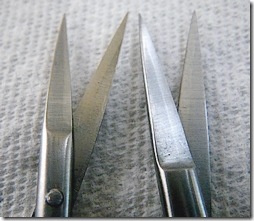 Part of selling all those Sixth Finger scissors is the quality control each set recieves prior to shipment. I’ve got a fairly consistent failure rate of nearly 10% on every shipment of scissors I receive.
Part of selling all those Sixth Finger scissors is the quality control each set recieves prior to shipment. I’ve got a fairly consistent failure rate of nearly 10% on every shipment of scissors I receive.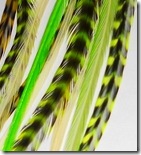 Never having seen an issue with as much bitter vitriol, that undoes 60 years of woman’s suffrage, polarizing the fly fishing community with tempers flaring in a frenzy of miscommunication and righteous anger …
Never having seen an issue with as much bitter vitriol, that undoes 60 years of woman’s suffrage, polarizing the fly fishing community with tempers flaring in a frenzy of miscommunication and righteous anger …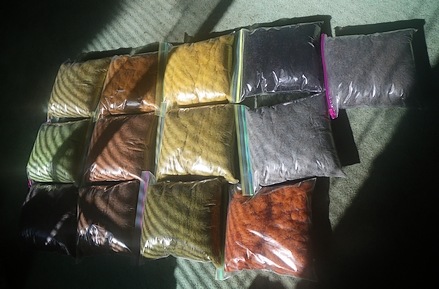
 Total dollar value for all farmed
Total dollar value for all farmed 


